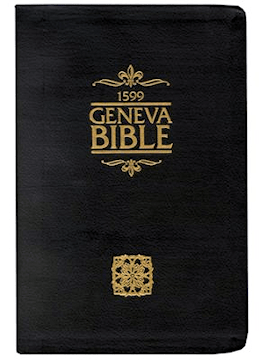Textus Receptus Bibles
Geneva Bible 1560/1599
| 4:1 | And the Angel that talked with mee, came againe and waked mee, as a man that is raysed out of his sleepe, |
| 4:2 | And saide vnto me, What seest thou? And I said, I haue looked, and beholde, a candlesticke all of gold with a bowle vpon the toppe of it, and his seuen lampes therein, and seuen pipes to the lampes, which were vpon the toppe thereof. |
| 4:3 | And two oliue trees ouer it, one vpon the right side of the bowle, and the other vpon the left side thereof. |
| 4:4 | So I answered, and spake to the Angel that talked with me, saying, What are these, my Lord? |
| 4:5 | Then the Angel that talked with mee, answered and said vnto me, Knowest thou not what these be? And I said, No, my Lord. |
| 4:6 | Then he answered and spake vnto me, saying, This is the word of the Lord vnto Zerubbabel, saying, Neither by an armie nor strength, but by my Spirit, saith the Lord of hostes. |
| 4:7 | Who art thou, O great mountaine, before Zerubbabel? thou shalt be a plaine, and he shall bring foorth the head stone thereof, with shoutings, crying, Grace, grace vnto it. |
| 4:8 | Moreouer, the word of the Lord came vnto me, saying, |
| 4:9 | The handes of Zerubbabel haue layde the foundation of this house: his handes shall also finish it, and thou shalt knowe that the Lord of hostes hath sent me vnto you. |
| 4:10 | For who hath despised the day of the small thinges? but they shall reioyce, and shall see the stone of tinne in the hand of Zerubbabel: these seuen are the eyes of the Lord, which go thorow the whole world. |
| 4:11 | Then answered I, and said vnto him, What are these two oliue trees vpon the right and vpon the left side thereof? |
| 4:12 | And I spake moreouer, and said vnto him, What bee these two oliue branches, which thorowe the two golden pipes emptie themselues into the golde? |
| 4:13 | And hee answered me, and saide, Knowest thou not what these bee? And I sayde, No, my Lord. |
| 4:14 | Then said he, These are the two oliue branches, that stand with the ruler of the whole earth. |

Geneva Bible 1560/1599
The Geneva Bible is one of the most influential and historically significant translations of the Bible into English, preceding the King James translation by 51 years. It was the primary Bible of 16th century Protestantism and was the Bible used by William Shakespeare, Oliver Cromwell, John Knox, John Donne, and John Bunyan. The language of the Geneva Bible was more forceful and vigorous and because of this, most readers strongly preferred this version at the time.
The Geneva Bible was produced by a group of English scholars who, fleeing from the reign of Queen Mary, had found refuge in Switzerland. During the reign of Queen Mary, no Bibles were printed in England, the English Bible was no longer used in churches and English Bibles already in churches were removed and burned. Mary was determined to return Britain to Roman Catholicism.
The first English Protestant to die during Mary's turbulent reign was John Rogers in 1555, who had been the editor of the Matthews Bible. At this time, hundreds of Protestants left England and headed for Geneva, a city which under the leadership of Calvin, had become the intellectual and spiritual capital of European Protestants.
One of these exiles was William Whittingham, a fellow of Christ Church at Oxford University, who had been a diplomat, a courtier, was much traveled and skilled in many languages including Greek and Hebrew. He eventually succeeded John Knox as the minister of the English congregation in Geneva. Whittingham went on to publish the 1560 Geneva Bible.
This version is significant because, it came with a variety of scriptural study guides and aids, which included verse citations that allow the reader to cross-reference one verse with numerous relevant verses in the rest of the Bible, introductions to each book of the Bible that acted to summarize all of the material that each book would cover, maps, tables, woodcut illustrations, indices, as well as other included features, all of which would eventually lead to the reputation of the Geneva Bible as history's very first study Bible.